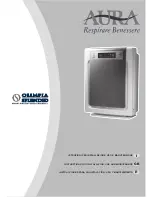
REYQ8~16M8W1B
VRVII System air conditioner
4PW23712-1
Installation manual
4
PRECAUTION
Block all gaps in the holes for passing out piping and wiring using
sealing material (field supply). (Small animals may enter the
machine.)
Example: passing piping out through the front
6. R
EFRIGERANT
PIPING
6.1.
Selection of piping material
1.
Foreign materials inside pipes (including oils for fabrication) must be
30 mg/10 m or less.
2.
Use the following material specification for refrigerant piping:
■
Size: determine the proper size referring to chapter
"6.3. Example of connection" on page 7
.
■
Construction material: phosphoric acid deoxidized seamless
copper for refrigerant.
■
Temper grade: use piping with temper grade in function of the
pipe diameter as listed in below table.
■
The pipe thickness of the refrigerant piping should comply
with relevant local and national regulations. The minimal pipe
thickness for R-410A piping must be in accordance with the
table below.
3.
Make sure to use the particular branches of piping that have been
selected referring to chapter
"6.3. Example of connection" on page 7
.
4.
In case the required pipe sizes (inch sizes) are not available, it is also
allowed to use other diameters (mm sizes), taken the following into
account:
■
select the pipe size nearest to the required size.
■
use the suitable adapters for the change-over from inch to
mm pipes (field supply).
6.2.
Connecting the refrigerant piping
1
Installation of refrigerant piping is possible as front connection or
side connection (when taken out from the bottom) as shown in
the figure.
Use R-410A to add refrigerant.
All field piping must be installed by a licensed refrigeration
technician and must comply with relevant local and
national regulations.
CAUTION TO BE TAKEN WHEN BRAZING
REFRIGERANT PIPING
Do not use flux when brazing copper-to-copper refrigerant
piping. (Particularly for the HFC refrigerant piping)
Therefore, use the phosphor copper brazing filler metal
(BCuP) which does not require flux.
Flux has extremely harmful influence on refrigerant piping
systems. For instance, if the chlorine based flux is used, it
will cause pipe corrosion or, in particular, if the flux
contains fluorine, it will damage the refrigerant oil.
Be sure to perform a nitrogen blow when brazing.
(Brazing without performing nitrogen replacement or
releasing nitrogen into the piping will create large
quantities of oxidized film on the inside of the pipes,
adversely affecting valves and compressors in the
refrigerating system and preventing normal operation.)
NOTE
Installation tools:
Make sure to use installation tools (gauge manifold
charge hose, etc.) that are exclusively used for R-410A
installations to withstand the pressure and to prevent
foreign materials (e.g. mineral oils such as SUNISO
and moisture) from mixing into the system.
(The screw specifications differ for R-410A and
R-407C.)
Vacuum pump (use a 2-stage vacuum pump with a
non-return valve):
■
Make sure the pump oil does not flow oppositely
into the system while the pump is not working.
1 2
3 4
1
Plug the areas marked with "
".
(When the piping is routed from the front
panel.)
2
Suction gas side piping
3
Liquid side piping
4
Discharge gas side piping
Pipe Ø
Temper grade of piping material
≤
15.9
O
≥
19.1
1/2H
O = Annealed
1/2H = Half hard
Pipe Ø
Minimal thickness
t (mm)
Pipe Ø
Minimal thickness
t (mm)
6.4
0.80
22.2
0.80
9.5
0.80
28.6
0.99
12.7
0.80
34.9
1.21
15.9
0.99
41.3
1.43
19.1
0.80
1
Left-side connection
2
Front connection
3
Right-side connection
1
2
3










































